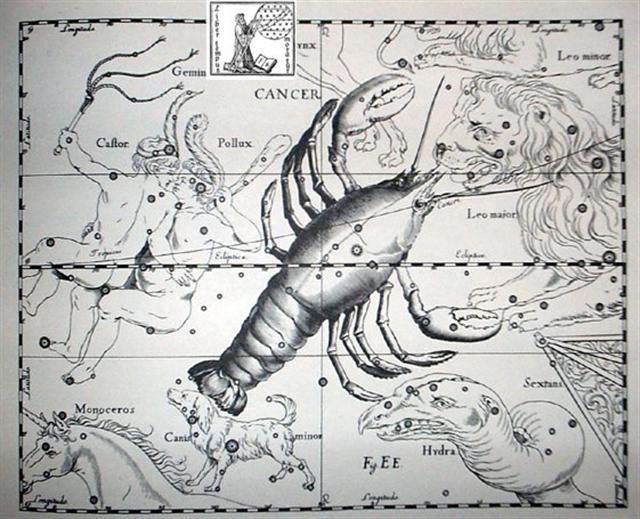|
2. From Honey to Ashes (by Claude LÚvi-Strauss): "... The ancient Chinese believed that with the arrival of the dry season the earth and sky ceased to communicate (Granet, p. 315, n. 1). The Spirit of drought was personified by a little bald woman│╣ with eyes at the top of her head. While she was present, the sky refrained from sending rain, so as not to harm her (ibid., n. 3) ... │╣ Hills and rivers are the first to suffer from drought. It deprives hills of their trees, i.e. their hair, and rivers of their fish, which are their people ... The same word, wang, means mad, deceitful, lame, hunchbacked, bald and Spirit of drought (Schafer)." The renewal of vegetation comes with the rains, and the rain is an aspect of the Sun. Nothing will grow when the earth has completely dried out, there will be no life. The barren shell of Cancer is a sign of death. The amusing little story of Lobster and Flounder (cfr at Eye in the Mud) might help us: ... Lobster said to Flounder: 'Let us-two hide from each other, see who is best at that.' Flounder agreed to play this game. Lobster went to a hole in the coral, hid his body; but his feelers stuck out, he could not hide them. Flounder knew where he was, found him. Said Flounder; 'Now it is my turn.' He stirred up a cloud of mud and scooted into it. Then he returned to Lobster's side, so quietly that Lobster did not know he was there. 'Here I am sir, Lobster!' Lobster was so angry at being beaten that he stamped on the fish and smashed him flat. Cried Flounder; 'Now I've got one eye in the mud!' Therefore Lobster gouged it out for him and roughly stuck it back on top. This is the reason why men tread on the Flounder, but can always see the Lobster's feelers outside his hole ... The Cancer constellation is sometimes depicted as a lobster (crayfish):
Mud is where life is born, a mixture of water and earth. South of the equator the eyes at the top of the little woman's dry head are changed into the eyes at the top of a fish down in the mud. When there is drought in high summer north of the equator it is the opposite in Polynesia (the story was told in Kapingamarangi, a Polynesian 'outlier' atoll). The star Acubens (α Canceri) is located not at the expected Ga3-11, where we could imagine a severed head at the bottom of a deep hole, but at glyph number 72 (= 360 / 5):
Sky (ragi) in Ga3-10 has no mata - no stars are shining in the night. Hau tea with 'Janus eyes' should indicate a solstice. Maybe the message is that beyond the solstice and a buried head new life will once again return. We should remember how on Hawaii the starving children were saved by Ku (cfr at The Queen of Hearts): ... the breadfruit originated from the sacrifice of the war god Ku. After deciding to live secretly among mortals as a farmer, Ku married and had children. He and his family lived happily until a famine seized their island. When he could no longer bear to watch his children suffer, Ku told his wife that he could deliver them from starvation, but to do so he would have to leave them. Reluctantly, she agreed, and at her word, Ku descended into the ground right where he had stood until only the top of his head was visible. His family waited around the spot he had last been, day and night watering it with their tears until suddenly a small green shoot appeared where Ku had stood. Quickly, the shoot grew into a tall and leafy tree that was laden with heavy breadfruits that Ku's family and neighbours gratefully ate, joyfully saved from starvation ... The carapace of a crab resembles the top of a human skull and the resemblance implies there must be something in common. The human skull also resembles a big nut. At Canopus the voyage goes deep down in the 'sea', and perhaps logic says next station should be inside 'earth' (as in a hole in coral rock or as in the mud where we cannot say whether it is earth or water). |



